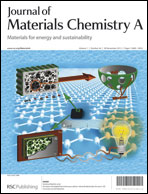One-step potentiodynamic synthesis of poly(1,5-diaminoanthraquinone)/reduced graphene oxide nanohybrid with improved electrocatalytic activity†
Abstract
In this work, we facilely synthesized poly(1,5-diaminoanthraquinone)/reduced graphene oxide (P(1,5-DAAQ)/RGO) nanohybrid through a one-step potentiodynamic deposition method (by changing the potential scanning range and direction), in which the 1,5-DAAQ monomer and GO acted as the starting materials. RGO was generated by cathodic electro-reduction of GO and P(1,5-DAAQ) polymer was simultaneously produced by in situ anodic electro-oxidative polymerization of the 1,5-DAAQ monomer. The morphology and microstructure of the resultant nanohybrid was fully characterized by field emission scanning electron microscopy (FE-SEM), energy dispersive X-ray spectroscopy (EDS), Fourier transform infrared spectroscopy (FT-IR), Raman spectroscopy, and X-ray photoelectron spectroscopy (XPS). Characterizations indicate that the P(1,5-DAAQ) polymer displays a barleycorn-like structure and is covalently grafted onto the RGO surface. The electrochemical properties and electrocatalytic activity of the P(1,5-DAAQ)/RGO nanohybrid were investigated using cyclic voltammetry (CV), electrochemical impedance spectroscopy (EIS) and rotating disk electrode (RDE) techniques. The P(1,5-DAAQ)/RGO nanohybrid shows higher electrical conductivity than that of 1,5-DAAQ/GO, since it has a lower concentration of oxy-functional groups after the potentiodynamic synthesis. The CV and RDE results reflect the fact that the P(1,5-DAAQ)/RGO nanohybrid possesses superior electrocatalytic activity toward the oxygen reduction reaction (ORR) with a long cycle life. The covalently grafted P(1,5-DAAQ) polymer on RGO sheets supplies sufficient electroactive sites (the π-conjugated system and the quinone groups), resulting in more favorable electron-transfer kinetics and greatly enhanced electrocatalytic performance for O2 reduction on the P(1,5-DAAQ)/RGO nanohybrid.


 Please wait while we load your content...
Please wait while we load your content...